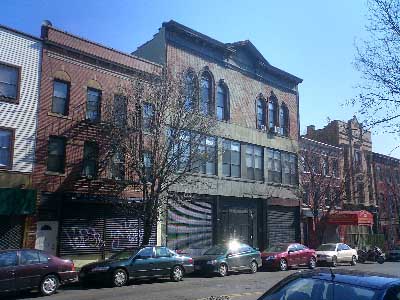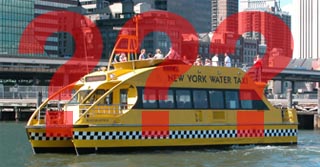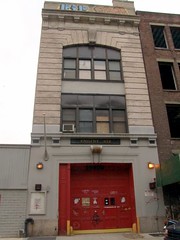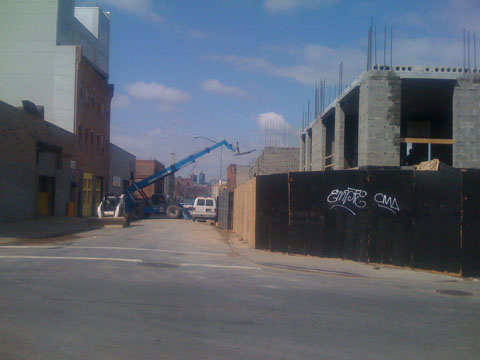
191 – 199 Grand Street
With all the vitriol passing back and forth over the Grand Street rezoning, perhaps its worth remembering why the City embarked on contextual zoning studies in the first place. Five or six years ago, when the City was first pulling together the large Greenpoint-Williamsburg Rezoning (aka the waterfront rezoning), R6 zoning was seen as pretty innocuous. Most developers opted to use the quality housing provisions of R6, which comes with height and density caps similar to those of R6A and R6B zoning. The height factor provisions were primarily used for center city development, not residential developments. Starting around 2003, Brooklyn began to see more and more of “height factor” buildings, some of them small and some them very large. Because vast stretches of residential Brooklyn are zoned R6, the proliferation of height factor buildings in what heretofore were low-rise rowhouse-scaled neighborhoods was a huge concern for both the communities involved and for the Department of City Planning (DCP). At the same time, the burgeoning housing boom was also resulting in abuses in R6 quality housing development, particularly with regard to the “community facility” bonus, which developers were using to boost narrow street FAR from 2.2 to as high as 4.8 FAR. These quality housing megabuildings, together with the new “finger buildings” allowed under height factor zoning were clearly a threat to the low-scale character of much of residential Brooklyn.
In many neighborhoods, R6 zoning has been in place since the 1961 zoning was instituted. For much of that time, there was little or no new development in residential Brooklyn, and what development there was generally fit within the comfortable confines of quality housing zoning. But as developers and architects started to push the envelope on R6 zoning, it became clear that what had been a acceptable zoning class for more than 40 years was suddenly a major threat to the character, scale and density in many neighborhoods.
So the City embarked on a series of rezonings. The Greenpoint-Williamsburg waterfront rezoning (enacted in May, 2005) was already underway, and most of the inland blocks there (more than 150 blocks) were switched from R6 to R6A or R6B. In response to the problems that had been cropping up with R6 development, the Borough President and City Council pressed the Bloomberg administration for a study all of the R6 areas within Community District 1 for potential contextual rezoning. It was this action, in May of 2005, that led directly to the Grand Street rezoning (and will lead to a far, far larger rezoning east of the BQE, still in the works at DCP).
In the 2005 waterfront rezoning, a number of blocks at the edges of the zoning area – such as along Metropolitan Avenue and Meeker Avenue – were left R6 in the original zoning. In a January, 2006 follow up action, contextual zoning was imposed on these blocks as well. (For whatever reason, two blocks of Metropolitan east of Havemeyer were left as R6.) This follow up action also instituted contextual zoning on the two blocks of Grand Street from Kent to Berry, and though the Community Board asked for the same treatment for the rest of Grand to the BQE, it was deemed out of scope by DCP.
While DCP was beginning discussions with Community Board 1 over potential study areas for further contextual zoning (as required by the agreement with City Council), it was actively developing contextual zoning plans for other Brooklyn neighborhoods as well. In fact, DCP has been incredibly busy in this regard. In 2007, contextual zoning was implemented on 206 blocks in Bedford-Stuyvesant South, 99 blocks of Fort Greene / Clinton Hill and 160 blocks in Dyker Heights / Ft. Hamilton. In 2006, the City rezoned almost 160 blocks in the Midwood, Homecrest and Sheepshead Bay neighborhoods; in 2005, almost 420 blocks were rezoned in South Park Slope, Bensonhurst and the Special Bay Ridge District; in 2003, 110 blocks were rezoned in Park Slope.
So lest anyone in the 13-block Grand Street rezoning area feel singled out by this latest action, bear in mind that over the course of five years, the City has imposed contextual zoning on over 1,300 blocks in 11 neighborhoods throughout Brooklyn. Some of these rezonings represented dramatic downzonings, with FAR cuts far beyond the 9% imposed on most of the owners in the Grand Street area. Many were carried out at the request of the local communities and with the support of local politicians. In each of these rezoning actions, there was a recognition that the existing zoning – R4, R5, R6 and R7 for the most part – was no longer appropriate for the character of the community.
In general terms, these rezonings follow a pretty standard (and desirable) model. Speaking of the Bed-Stuy South rezoning, DCP had this to say: “The proposed rezoning aims to preserve neighborhood scale and character, maintain opportunities for mid-rise apartment building construction along appropriate corridors, and allow for residential growth with incentives for affordable housing along the Fulton Street transit and retail corridor”. That is exactly what the Fort Greene/Clinton Hill rezoning did, it is exactly what the Williamsburg/Greenpoint rezoning did, and it is exactly what the Grand Rezoning did. In the case of Grand Street, the higher density zoning (“opportunities for mid-rise apartments”) were located on Metropolitan, a wide street that is also a major thoroughfare. Neighborhood scale and character were maintained along Grand, South 1st, North 1st, Fillmore and the avenues with R6B zoning. In the case of Grand Street, this is appropriate because Grand has a context that is generally three and four story buildings, with an average height somewhere around 40′ (there is only one six story building on this entire stretch of Grand Street, and only a handful of other buildings that break 50′). Grand Street is also not a wide street (in the zoning sense), and, with the construction of the BQE, no longer a through street.
In the 2005 Williamsburg/Greenpoint rezoning, the community (through both the ad hoc rezoning committee and the Community Board) supported contextual zoning in the Northside and in the western portions of Greenpoint. By and large, the community felt at the time that the extent of R6A zoning proposed by DCP was too much, that it would result in out-of-character buildings, and that the neighborhood’s infrastructure couldn’t handle the number of people this would bring. The City’s contention (which won the day) was that R6A was needed in order to encourage the redevelopment of the formerly manufacturing areas to the east and west of the core Northside neighborhood (which was rezoned R6B).
From the point of view of the community at large, contextual zoning clearly makes sense. It limits out of scale development (both finger buildings and bonused behemoths under quality housing). It concentrates higher density development along avenues and near transportation nodes, allowing a finer application of zoning than a blanket R6. It introduces bonuses for inclusionary (affordable) housing. In the long run, it will help maintain property values by controlling (but not overly limiting) growth and maintaining the low-scale residential and mixed-use character that drew so many people to the neighborhood in the first place. Contextual zoning also discourages the massive lot (or air rights) assemblages that result in demolition of character-defining buildings and the construction of finger buildings or quality housing behemoths.
The fact that the contextual zoning categories do not match up one to one with the non-contextual categories has resulted in the loss of about 9% of allowable floor area (2.2 FAR to 2.0 FAR) in much of the Grand Street district. While some wild numbers ($100 million, $400 million) have been thrown around, the truth is that the full impact of this is only felt by the development sites. For those unimproved properties, the value of the land is the value of the property, and the two correlate almost directly with the allowable floor area. So if you reduce FAR by 9%, you probably reduce the value of the property by 9%. The same is not true of improved properties – there, the value of the land is only a part of the value of the overall property. And since each property is different – some are overbuilt, some underbuilt, some have grandfathered uses, etc. – the cumulative economic impact is nearly impossible to measure. And that’s without factoring in the positive (yet intangible) economic effects of this rezoning mentioned above. Those effects are more long term, but if you weigh all of the different factors, for the vast majority of property owners the overall economic impact of this rezoning is probably a wash, or pretty darn close.
For some owners (perhaps 10% of the total), the rezoning could actually be seen as a boon. That would be the owners of wide street properties who were rezoned from R6 to R6A. For them, the floor area remains the same, albeit with height caps, so the intangible community-wide benefits could actually result in an increase in property values, at least in the long term. On the other hand, for wide street property owners that have been rezoned to R6B, the economic impact is clearly negative. This is also a minority (between 10% and 15%), and again, the effects are not evenly distributed. All of these owners see their FAR drop by a third, but since most of these properties are not development sites, the actual value of each property does not drop by a third. The value of the underlying land does theoretically drop by a third, but with the exception of developers and speculators, most people buy for the improvement (the building), not the land value.
Again, from an macro, urbanist, neighborhood-wide point of view, contextual zoning is a good thing. It maintains neighborhood character and scale, discourages tear downs, allocates height and density more rationally, and allows for bonuses for something the community needs – affordable housing. It eliminates finger buildings and the much-abused community facility bonus. That is why so many neighborhoods have pushed for contextual zoning. That is why neighborhoods like Carroll Gardens are jumping up and down demanding contextual zoning (and getting pretty upset when told they have to wait for the “East Greenpoint” contextual zoning).
Unfortunately, with the Grand Street rezoning, a small number of owners in the midst of development projects have combined with a large number of owners with little or no information about why the zoning was done or how it actually impacts them to try to overturn the whole zoning. Clearly owners in the process of development are impacted, if only by the loss of time (which = money), but also by having to redo plans and reduce height and floor area. But for 95% of the property owners, the consequences are not that dire, and quite possibly not dire at all. All of this has split the neighborhood, most unneccesarily. Hopefully both sides (and there is plenty of bad blood on both sides) will take a step back, take time to understand the situation, and get back to life as normal. Because for most people, very little has changed with the Grand Street rezoning.






